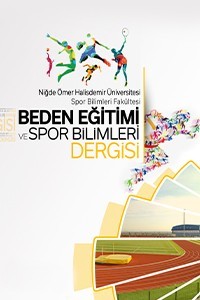MÜCADELE SPORLARINDA ANTRENÖR-SPORCU İLİŞKİLERİ VE LİDERLİĞİN YAŞ, CİNSİYET VE KATILIM SÜRESİ DEĞİŞKENLERİ AÇISINDAN İNCELENMESİ
Mücadele sporları, antrenör-sporcu ilişkileri, sporda liderlik, koçluk
EXAMINATION OF COACH-ATHLETE RELATIONSHIPS AND LEADERSHIP IN TERMS OF AGE, GENDER, AND PARTICIPATION DURATION VARIABLES IN MARTIAL ARTS
Martial arts, coach-athlete relationships, sports leadership, coaching,
___
- Adie, J. W., & Jowett, S. (2010). Meta‐perceptions of the coach–athlete relationship, achievement goals, and intrinsic motivation among sport participants. Journal of Applied Social Psychology, 40(11), 2750- 2773.
- Altıntaş, A., Çetinkalp, Z. K., & Aşçı, F. H. (2012).
- Evaluating the Coach-Athlete Relationship: Validity and Reliability Study. Hacettepe J. of Sport Sciences, 23(3), 119-128.
- Carli, L. L. (2001). Gender and social influence.
- Journal of Social Issues, 57(4), 725-741.
- Çakıoğlu, A. (2003). In partial fulfillment of the
- requırements for the degree of master of science in the department of physical education and sport. Ankara: Middle East Technical Unıversity, Master Thesis.
- Cengiz, R., Aytan, G. K. & Abakay, U. (2012). The relationship leadership qualities that the taekwondo athlete perceive. Sport Sciences, 7(4), 68-78. and
- Chelladurai, P. (1984). Discrepancy between preferences and perceptions of leadership behavior and satisfaction of athletes in varying sports. Journal of Sport Psychology, 6(1), 27-41.
- Chelladurai, P. (2007). Leadership in sports. In G. Tenenbaum.,& R.C. Eklund (Eds.), The handbook of sport psychology (3rd edition, pp. 113-135). New York: Wiley
- Chelladurai, P., & Saleh, S. D. (1980). Dimensions of leader behavior in sports: Development of a leadership scale. Journal of Sport Psychology, 2(1), 34-45.
- Chelladurai, P., & Riemer, H.A. (1998). Measurement of leadership in sport. In J.L. Duda (Ed.), Advances in sport and exercise psychology measurement (pp. 227–253). Morgantown, WV: Fitness Information Technology.
- Charbonneau, D., Barling, J.& Kelloway, KE. (2001). Transformational performance: The mediating role of intrinsic motivation. Journal of Applied Social Psychology, 31(7), 1521–1534. and sports
- Eagly, A. H. (1983). Gender and social influence: A social psychological analysis. American
- Psychologist, 38(9), 971-981.
- Eagly, A. H., & Carli, L. L. (1981). Sex of researchers
- and sex-typed communications as determinants of sex differences in influenceability: A meta-analysis of social Bulletin, 90(1), 1. studies. Psychological
- Gardner, D. E., Shields, D. L. L., Light Bredemeier, B. J., & Bostrom, A. (1996). The relationship between perceived coaching behaviors and team cohesion among baseball and softball players. Sport Psychologist, 10, 367-381.
- George, D., & Mallery, P. (2016). IBM SPSS Statistics 23 Step by Step: A Simple Guide and Reference. s. 116, Routledge.
- Jackson, B., Grove, J. R., & Beauchamp, M. R. (2010). Relational efficacy beliefs and relationship quality within coach-athlete dyads. Journal of Social and Personal Relationships, 27(8), 1035-1050.
- Jowett, S. (2003). When the honeymoon is over: A case study of a coach-athlete dyad in crisis. Sport Psychologist, (17), 444-460.
- Jowett, S. (2005). The coach-athlete partnership. The Psychologist, 18(7), 412-415.
- Jowett, S., & Chaundy, V. (2004). An Investigation Into the Impact of Coach Leadership and Coach- Athlete Relationship on Group Cohesion. Group Dynamics: Theory, Research, and Practice, 8(4), 302-311.
- Jowett, S., & Cockerill, I. M. (2002) Incompatibility in the coach–athlete relationship. In I. M. Cockerill (Ed.), Solutions in sport psychology. (pp. 16–31) London: Thompson Learning.
- Jowett, S., & Cockerill, I. M. (2003). Olympic medallists’ perspective of the althlete-coach relationship. Psychology of sport and exercise, 4(4), 313-331. 21. Jowett, S., &
- Poczwardowski, A. (2007).
- Understanding the Coach-Athlete Relationship. In S.
- Jowett, & D. Lavallee (Eds.), Social psychology in
- sport (pp. 3-14). Champaign, IL: Human Kinetics, Inc.
- Jowett, S., & Meek, G. A. (2000). The coach-athlete relationship in married couples: An exploratory content analysis. Sport Psychologist, 14(2), 157-175.
- Jowett, S., & Ntoumanis, N. (2004). The coach– athlete Development and initial validation. Scandinavian Journal of Medicine & Science in Sports, 14(4), 245- 257. questionnaire (CART‐Q)
- Hampson, R., & Jowett, S. (2014). Effects of coach leadership and coach–athlete relationship on collective efficacy. Scandinavian Journal of Medicine & Science in Sports, 24(2), 454-460.
- Hastie, P. A. (1993). Coaching preferences of high school girl volleyball players. Perceptual and Motor skills, 77(3), 1309-1310.
- Krosnick, J. A., & Alwin, D. F. (1989). Aging and
- susceptibility to attitude personality and social psychology, 57(3), 416-425.
- Olympiou, A., Jowett, S., & Duda, J. L. (2008). The psychological interface between the coach-created motivational relationship in team sports. The Sport Psychologist, 22(4), 423-438. and the coach-athlete
- Philippe, R. A., & Seiler, R. (2006). Closeness, co- orientation and complementarity in coach–athlete relationships: What male swimmers say about their male coaches. Psychology of Sport and Exercise, 7(2), 159-171.
- Pyun, D.Y., Kwon, H. H., Koh, K. T., & Wang, C. K. J. (2010). Perceived coaching leadership of youth athletes in Singapore. Journal of Sport Behavior, 33(1), 25-41.
- Riemer, H. A., & Toon, K. (2001). Leadership and satisfaction in tennis: Examination of congruence, gender, and ability. Research Quarterly for Exercise and Sport, 72(3), 243-256. 31. Rowold, J. (2006).
- Transformational and
- transactional leadership in martial arts. Journal of
- Applied Sport Psychology, 18(4), 312-325.
- Stornes, T., & Bru, E. (2002). Sportspersonship and perceptions of leadership: An investigation of adolescent sportspersonship and associations with perceived leadership. European Journal of Sport Science, 2(6), 1-15. players' perceptions of
- Toros, T. (2011). The relationship between perceived coaching behaviors, goal orientation, team cohesion, perceived motivational climate ve collective efficacy among basketball players before and after the tournament. Journal of Human Sciences, 7(2), 1118- 1142.
- Toros, T. ve Tiryaki, Ş. (2006). “Sporda Liderlik
- Ölçeği’nin - Futbolcuların Antrenör Davranışlarını Algılaması Versiyonunun- Geçerlik ve Güvenirlik Çalışması”. 9. Uluslararası Spor Bilimleri Kongresi, 3- 5 Kasım, Muğla, Türkiye. [In Turkish]
- ISSN: 1307-6477
- Yayın Aralığı: Yılda 3 Sayı
- Başlangıç: 2007
- Yayıncı: Niğde Ömer Halisdemir Üniversitesi
Necdet Eray PİŞKİN, Cemal Berkan ALPAY
FARKLI BRANŞLARDAKİ ÖĞRETMENLERİN SPORA YÖNELİK TUTUMLARININ İNCELENMESİ
Gülşah ÜNVER, Ersan KARA, Hikmet KOCAMAN
Merve Koca KOSOVA, Sercin KOSOVA, Atalay ARKAN
Sinan YILDIRIM, Alper YILDIZ, Ziya KORUÇ
ZİHİNSEL YETERSİZLİK, SPOR VE RUHSAL UYUM İLİŞKİSİ
